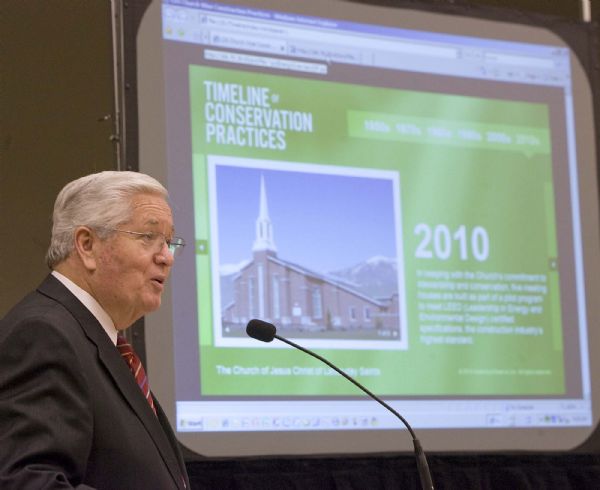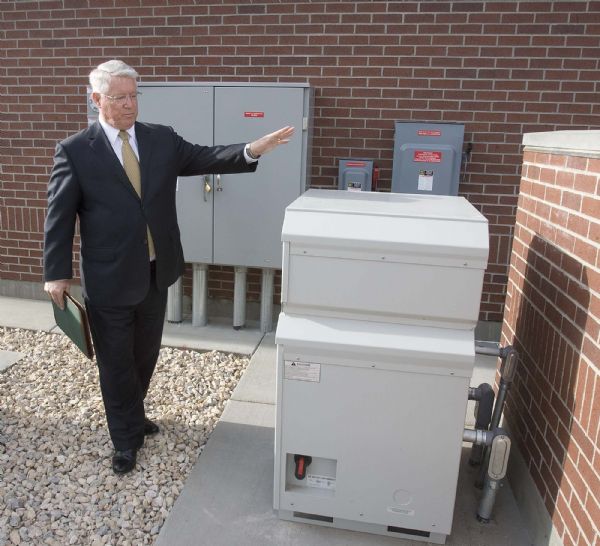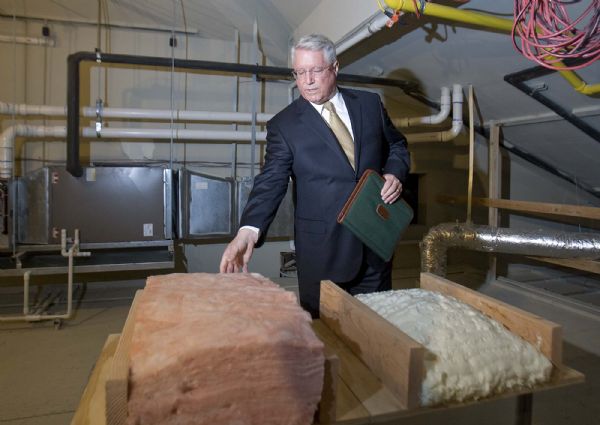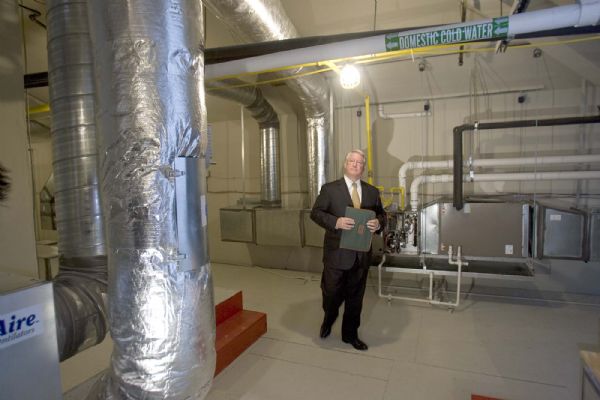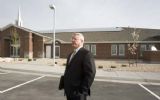This is an archived article that was published on sltrib.com in 2010, and information in the article may be outdated. It is provided only for personal research purposes and may not be reprinted.
Farmington » LDS Church leaders Tuesday unveiled the meetinghouse of the future -- and it's a "green" one.
They showcased one of five prototypes, a Farmington stake center that sports 156 solar panels, xeriscaped landscaping, even designated parking for electric cars.
"There is something very doctrinally sound when we talk about conservation of resources," said H. David Burton, presiding bishop of the 13.8 million-member faith.
Latter-day Saints, he said, might consider their own environmental stewardship.
"This is a teaching moment," Burton said. "This aspect of our culture has become a vital part of our DNA."
Journalists from along the Wasatch Front toured the new meetinghouse, which the church built to silver standards of Leadership in Energy and Environmental Design (LEED) certification.
It will be the second LDS building to earn such status. The first was the new Church History Library, completed last summer in downtown Salt Lake City.
The stake center, which can serve three wards, or congregations of The Church of Jesus Christ of Latter-day Saints, is one of five such buildings under construction in Utah, Nevada and Arizona to assess the benefits of going green.
Dean Davies, managing director of physical facilities for the Utah-based faith, said he expects every future meetinghouse -- the church builds more than 200 a year -- to spring from the prototypes, including one without solar power under construction in the Utah County community of Eagle Mountain.
The others, with flatter roofs, are going up in Apache Junction, Ariz., and Logandale and Pahrump, Nev. The Farmington meetinghouse will be ready for occupancy in a month or six weeks.
One change that has less to do with the environment than members' worship experience is the new shape of chapels inside the building.
Instead of horizontal rows, the pews will be arrayed in a fan to create a more "intimate" connection between the pulpit and congregation, Davies said. Cultural halls, doubling as gyms and auditoriums, will be perpendicular to the chapels.
Employing "green" technologies is not new to the LDS Church. Indeed, Tuesday's news conference highlighted past earth-friendly efforts such as the geothermal plant built in the 1980s to power a California meetinghouse and the fact that rainwater has been collected since the 1950s at Pacific Island church buildings.
"This is another step," Burton said, "in our program to be environmentally responsible."
Davies said the church also will weigh whether older church buildings can be modernized with green features.
"One of the questions we're asking," he said, "is whether we should retrofit all of our meetinghouses [with solar panels]."
Elaine Emmi, one of the founders of Utah Interfaith Power and Light, said she was "doing a happy dance" after Tuesday's announcement.
The group has been encouraging -- with some success -- faith communities to retrofit buildings or adopt energy-saving measures. It even provides energy audits.
The LDS initiative is huge, she said, given its predominance in Utah. " It's the key to everything. They will become a leader in getting other faith communities to follow suit."
The new Farmington meetinghouse, Davies said, will be about 30 percent more energy efficient than any ever built by the church. It is insulated with polyurethane foam, uses highly efficient windows, carpet made from recycled materials, tankless water heaters and European-style toilets that offer the choice of little or lots of water with each flush.
The heating and air-conditioning system will be fully automated for optimum efficiency. Sensors will turn off lights when people are not in rooms.
Recycling bins for paper, glass and plastics will be a first for an LDS meetinghouse, Davies said.
A monitor in the church's materials center, or library, will show congregants just how much electricity the solar panels are generating and how much is being used.
Outside, about 70 percent of the landscaping is in rock or bark, and the irrigation system has sensors to guide watering based on need rather than a schedule.
Davies said the environmental measures added about $1.84 per square foot to the building tab, an amount he considers "almost inconsequential." It will be repaid through energy savings. The solar panels, which cost several hundred thousand dollars, will provide all the electricity, shaving costs by $6,000 a year.
"The long-term total cost," he said, "will actually be less with this building."
Burton said such savings are good, but there is more to the increased environmental awareness.
"We want to be responsible members of the community as well, and I mean the community of man."
LDS Church shows off its new 'green' meetinghouse
Farmington, Utah
Eagle Mountain, Utah
Apache Junction, Ariz.
Logandale, Nev.
Pahrump, Nev.


